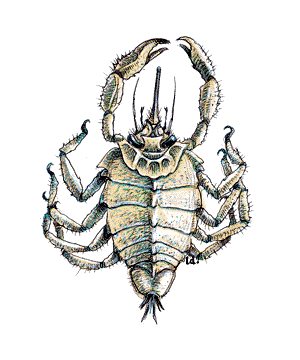

2140

| Climate/Terrain: | Subterranean |
|---|---|
| Frequency: | Rare |
| Organization: | Group |
| Activity Cycle: | Night |
| Diet: | Carnivore |
| Intelligence: | Semi- (2-4) |
| Treasure: | Any |
| Alignment: | Neutral |
| No. Appearing: | 1-4 |
| Armor Class: | 4 |
| Movement: | 1 |
| Hit Dice: | 3 |
| THAC0: | 17 or 15 (see below) |
| No. of Attacks: | 2 |
| Damage/Attack: | 2-8 (2d4)/2-8 (2d4) |
| Special Attacks: | Adhesive trapline |
| Special Defenses: | See below |
| Magic Resistance: | Nil |
| Size: | M (7’ long) |
| Morale: | Steady (11-12) |
| XP Value: | 175 |
The cave fisher is a large insectoid that has adapted to life below ground. It combines many of the characteristics of a spider and a lobster.
The cave fisher has a hard, chitinous shell of overlapping plates and eight legs. The 6 rear legs are used for movement and traction on stony walls and corridors. Because of these limbs, the fisher has no difficulty in moving up and down vertical walls. The front pair of legs are equipped with powerful pincers, which are used for killing and dismembering prey. The most unusual feature of the cave fisher is its long snout, which can fire a strong, adhesive filament. The monster can also use its adhesive to anchor itself in place on walls and ledges.
Combat: The cave fisher has two ways of hunting. Its preferred method is to string its long filament in the vicinity of its lair. The filaments are thin and strong, making them exceedingly difficult to detect or cut. There is only a 20% chance of noticing the strand at 10’, and no chance at all of seeing them at a greater distance. A detect snares and pits spell will reveal a strand. The filament is coated with an adhesive which can only be dissolved by liquids with a high alcohol content (such as the cave fisher’s blood). The filaments can only be cut by +1 or better edged weapons.
The fisher’s favorite food are small, flying creatures like bats. Ever opportunistic, they are constantly trying to vary their diet by trapping a careless adventurer, foolish goblin, or orc (provided that they think that they can get away with it). If more than one fisher inhabits a lair, they will frequently pool their resources to catch larger prey. Once the victim is trapped in the filament, the cave fisher draws its prey in, reeling its filament in like a fishing line.
Should a tempting target escape the monster’s neatly laid traps, the cave fisher will try another mode of attack. It will spend one round drawing its filament in and then shoot it at the prey, striking as a 6 Hit Die monster. It will try to snare its prey in this manner so long as it remains within the fisher’s established territory. If the prey is hit by the filament, the monster can pull a weight of up to 400 pounds at a movement rate of 15’ per round. In the event that a “tug of war” breaks out, the fisher has a strength of 18/00 with its strand.
Habitat/Society: Cave fishers prefer living on ledges and caves located above well-traveled paths, sharing their lairs with others of their kind. No more than four cave fishers will be found in one lair. Their filaments are always strung before their lair, and they attempt to kill anything they trap, often storing food for future use.
Their territories are very small, and never larger than about 300 feet to either side of the lair. Anything man-sized or smaller is considered fair game by the cave fisher and halflings are thought to be tasty treats. A single cave fisher would never attack a large, well armed party for the sake of a single meal.
Still, they are cunning, and a group of the monsters might reel in their filaments and attempt an ambush if they thought they could get away with it. If hunting in one area becomes scarce, the cave fisher will simply find a new area to hunt, where the small game is more plentiful and careless.
Like all predators, the cave fisher is interested in survival. This means a steady supply of food and a mate. Females lay eggs in the vicinity of the lair, which they protect from predators. The young scatter when the eggs hatch, seeking lairs of their own.
Although the cave fisher does not collect treasure, its lair is often strewn with the possessions of its former victims.
Ecology: The cave fisher preys primarily on small flying game, and in the subterranean world this frequently means a diet of bats. It is not the top predator in its ecological niche, and has learned caution in dealing with other monsters. The cave fisher is sufficiently intelligent to know the dangers of preying on large, well-organized groups, who might grow tired of its depredations and hunt it to extinction. The monster instinctively picks the easiest route for survival, and relies on stealth and cunning to trap its prey and avoid being eaten itself.
The filaments of the cave fisher are highly prized by many thieves’ guilds, for they can be made into thin and very strong rope which is nearly invisible. The filaments are wound onto reels and then specially treated to dilute the adhesive. The resulting strands are made into ropes, while the diluted adhesive is turned into a special solution, which when applied to gloves and boots, greatly increases traction for climbing.

◆ 278 ◆